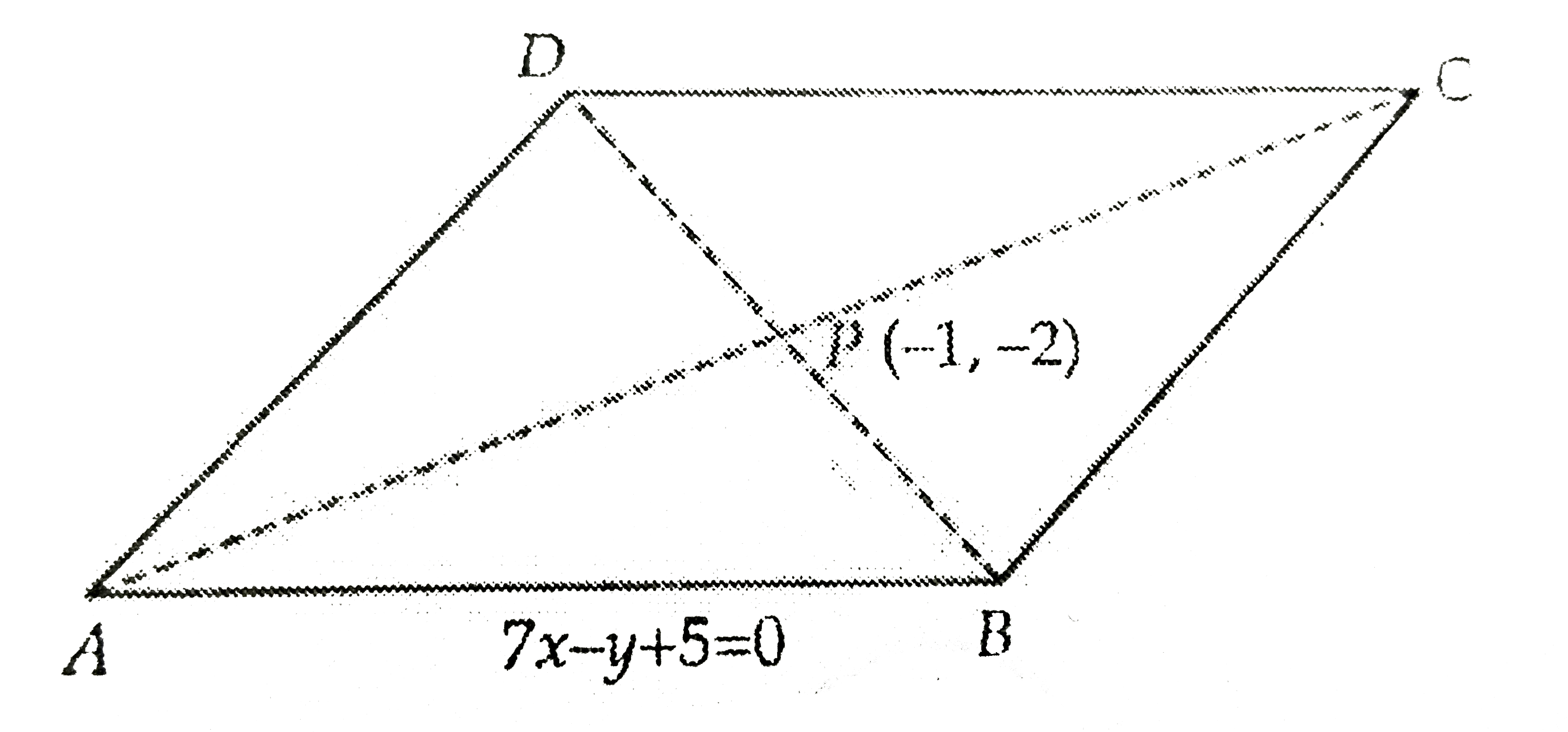Two sides of a rhombus are along the lines,x−y+1=0 and 7x−y−5=0 . If its diagonals intersect at (−1,−2) , then which one of the following is a vertex of this rhombus ? (1) (−3,−9) (2) (−3,−8) (3) (13,−83) (4) (−103,−73)
(-3 , -8)
(13,−83)
(−103,−73)
(-3 , -9)
The correct Answer is:B
Let the equations of sides AB and AD be 7x - y - 5 = 0 and x - y + 1 = 0 respectively . Solving these two equations the coordinates of vertex A are (1,2)
Let the coordinates of C be (α,β) . Since P(-1,-2) is the mid point of AC
∴α+12=−1 and β+22=−2⇒α=−3andβ=−6

So , the coordinates of C are (-3,-6)
Hence , the equations of BC and CD are x - y - 3 = 0 and 7x - y + 15 = 0 respectively . Solving equations of AD and CD ,
we find that the coordintes of D are (−73,−103) . Since P is the mid point of BD . So , coordinate of B are (13,−83) .
Topper's Solved these Questions
- BOOK - OBJECTIVE RD SHARMACHAPTER - STRAIGHT LINESEXERCISE - Section-1 Solved MCQs (Example)1videos
STRAIGHT LINES
- BOOK - OBJECTIVE RD SHARMACHAPTER - STRAIGHT LINESEXERCISE - SECTION - II (ASSERTION - REASON TYPE MCQs)14videos
STRAIGHT LINES
- BOOK - OBJECTIVE RD SHARMACHAPTER - STRAIGHT LINESEXERCISE - ILLUSTRATION 181videos
STRAIGHT LINES
- BOOK - OBJECTIVE RD SHARMACHAPTER - SETSEXERCISE - Chapter Test30videos
SETS
Similar Questions
Two sides of a parallelogram are along the lines x+y=3 and x−y+3=0 .If its diagonal intersect at (2,4) then one of its vertex is
View SolutionTwo sides of a Rhombus ABCD are parallel to the lines x−y=5 and 7x−y=3. The diagonals intersect at (2,1) then the equations of the diagonals are
View Solution
Knowledge Check
- Question 1 - Select One
Two sides of a parallelogram are along the lines x+y=3 and x=y+3. If its diagonals intersect at (2, 4) , then one of its vertices is
A(2, 6)B(2,1)C(3, 5)D(6,3) - Question 2 - Select One
The sides of a rhombus ABCD are parallel to the lines x−y+2=0 and 7x−y+3=0, If the diagonals of the rhombus intersect at P(1,2) and the vertex A (different from the origin) is on the y-axis then the ordinate of A is:
A2B52C74D72 - Question 3 - Select One
One side of a rectangle lies along the line 4x + 7y + 5 = 0. Two of its vertices are (-3, 1) and (1, 1). Which of the following is not an equation of the other three straight lines?
A14x - 8y = 6B7x - 4y = -25C4 x + 7y = 11D14 -8y = - 25
Two adjacent sides of a rhombus are 2x+3y=a−5 and 3x+2y=4−2a and its diagonals intersect at the point (1,2) then a can be
View SolutionSides of a rhombus are parallel to x+y=0,7x=y. Its centre is (2,7), then its diagonals are
View SolutionTwo sides of a rhombus ABCD are parallel to the lines y = x + 2 and y = 7x + 3 If the diagonals of the rhombus intersect at the point (1, 2) and the vertex A is on the y-axis, then vertex A can be
View SolutionTwo sides of a rhombus lying in the first quadrant are given by 3x−4y=0 and 12x−5y=0. If the length of the longer diagonal is 12, then find the equations of the other two sides of the rhombus.
View SolutionThe sides of a rhombus are parallel to the lines x+y−1=0 and 7x−y−5=0. It is given that the diagonals of the rhombus intersect at (1, 3) and one vertex, A of the rhombus lies on the line y=2x . Then the coordinates of vertex A are (a)(85,165) (b) (715,1415) (c)(65,125) (d) (415,815)
View Solution
